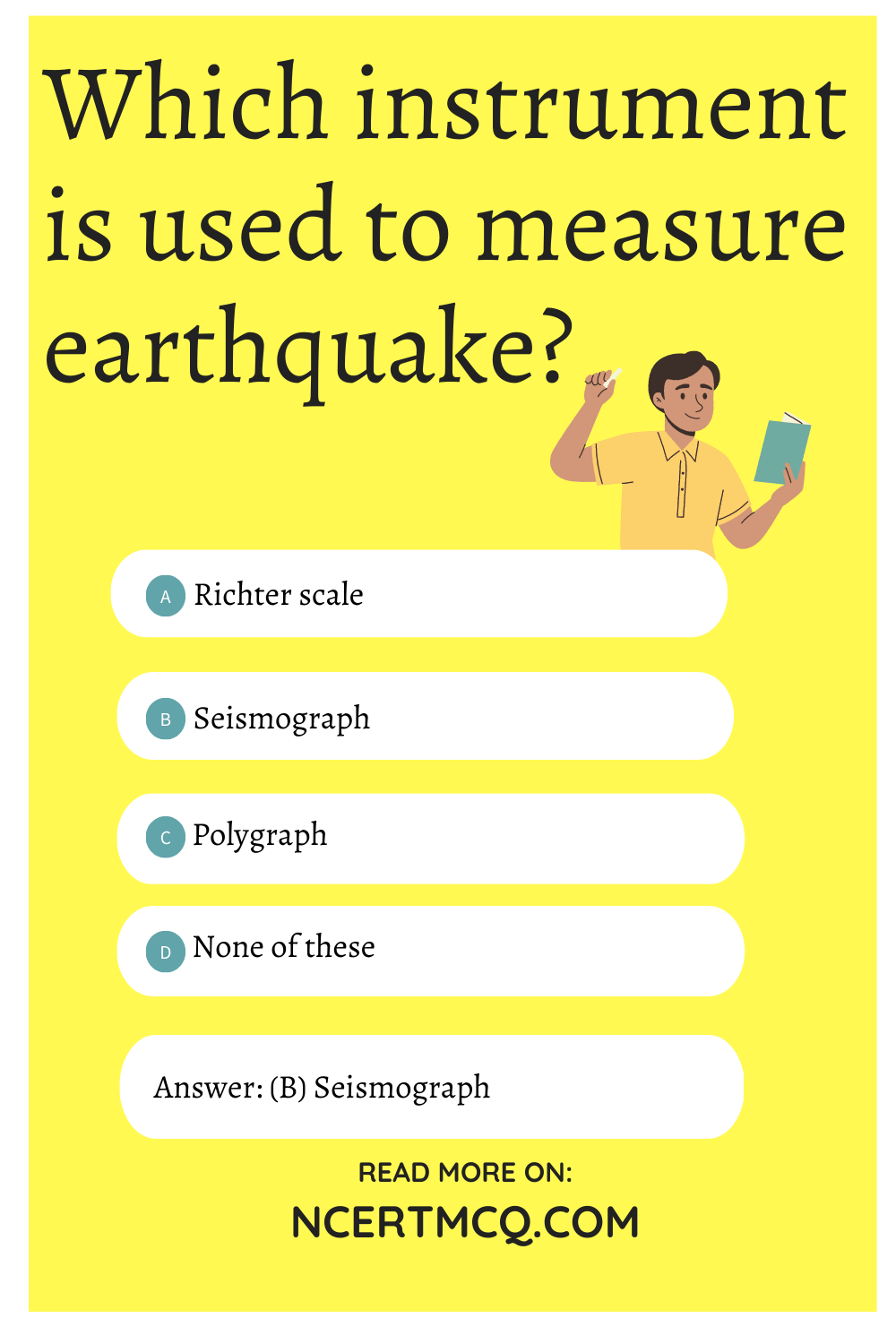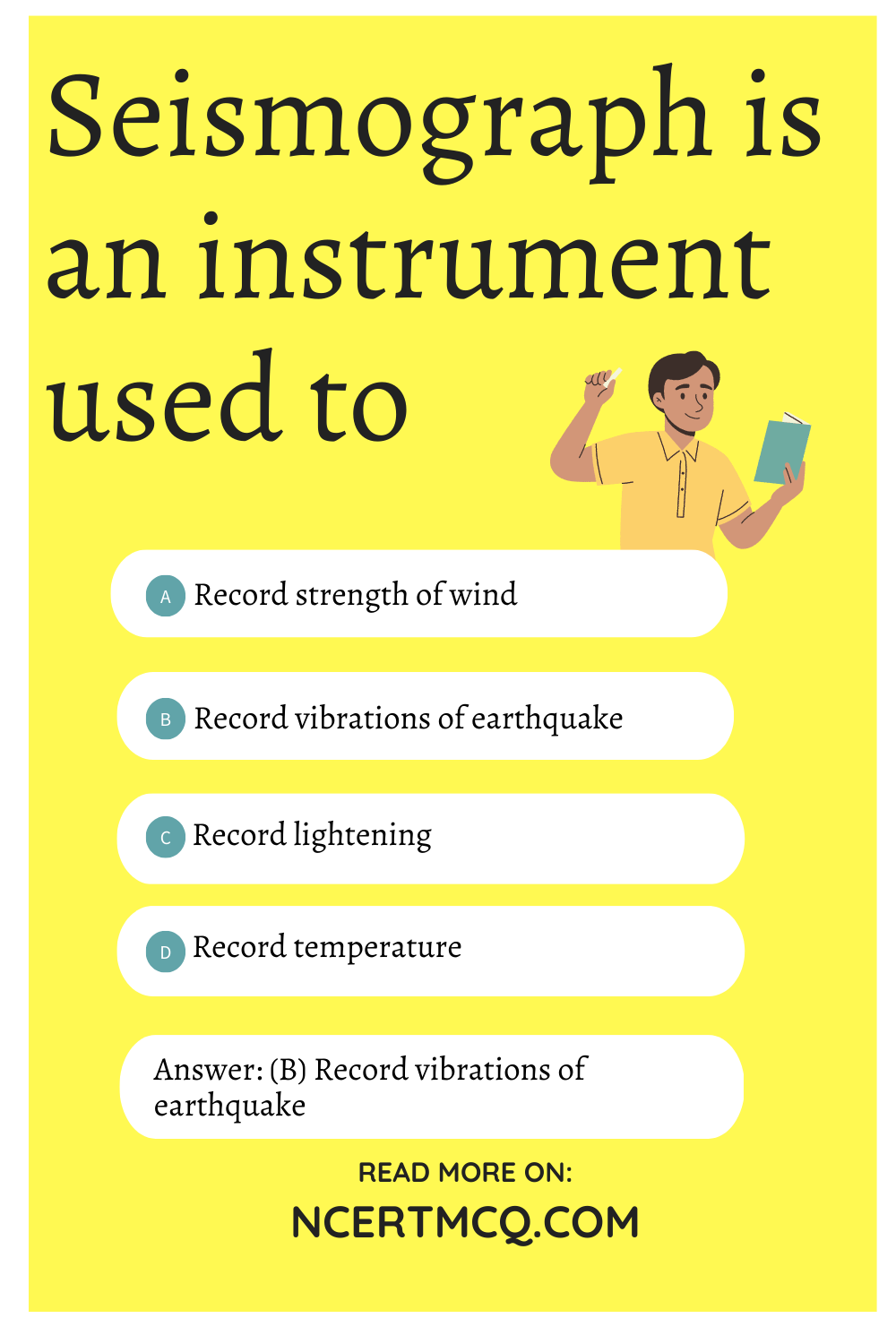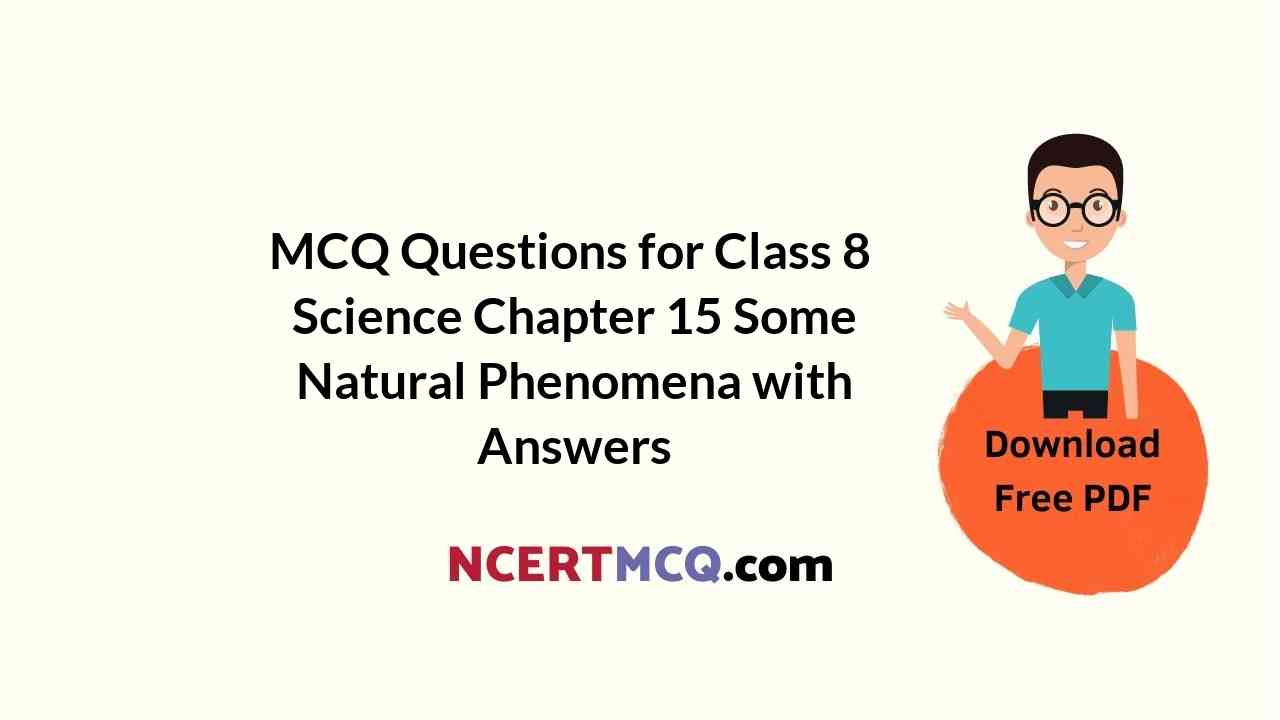Check the below Online Education NCERT MCQ Questions for Class 8 Science Chapter 15 Some Natural Phenomena with Answers Pdf free download. MCQ Questions for Class 8 Science with Answers were prepared based on the latest exam pattern. We have provided Some Natural Phenomena Class 8 Science MCQs Questions with Answers to help students understand the concept very well. https://ncertmcq.com/mcq-questions-for-class-8-science-with-answers/
You can refer to NCERT Solutions for Class 8 Science Chapter 15 Some Natural Phenomena to revise the concepts in the syllabus effectively and improve your chances of securing high marks in your board exams.
Class 8 Science Chapter 15 MCQ With Answers
Science Class 8 Chapter 15 MCQs On Some Natural Phenomena
Choose the correct option in the following questions:
Some Natural Phenomena Class 8 MCQ Question 1.
The process of transfer of charges from a charged object to the earth is called
(a) earthing
(b) lightning
(c) oscillation motion
(d) electron movement
Answer
Answer: (a) earthing
Class 8 Science Chapter 15 MCQ Question 2.
The power of an earthquake is expressed on a scale called
(a) seismic scale
(b) iron scale
(c) richter scale
(d) large scale
Answer
Answer: (c) richter scale
Natural Phenomena Class 8 MCQ Question 3.
Which instrument is used to measure earthquake?
(a) Richter scale
(b) Seismograph
(c) Polygraph
(d) None of these
Answer
Answer: (b) Seismograph

Class 8 Some Natural Phenomena MCQ Question 4.
Which is not a natural phenomena?
(a) Earthquakes
(b) Cyclones
(c) Lightning
(d) Earthing
Answer
Answer: (d) Earthing
MCQ On Some Natural Phenomena Class 8 Question 5.
How many types of charges are gained by rubbing objects?
(a) 2
(b) 1
(c) 3
(d) 4
Answer
Answer: (a) 2
Class 8 Science Ch 15 MCQ Question 6.
Where is the lightning rod attached to protect the building from lightning?
(a) On the top of the building
(b) On the bottom of the building
(c) In the middle of the building
(d) All of these
Answer
Answer: (a) On the top of the building
MCQ Questions For Class 8 Science Chapter 15 Question 7.
Lightning always follows
(a) a thunder
(b) rain pour
(c) the easiest path
(d) a straight path
Answer
Answer: (a) a thunder
Some Natural Phenomena Class 8 MCQ With Answers Question 8.
Tsunami means
(a) earthquake
(b) floods
(c) earthquake under the sea
(d) eruption of volcano in a sea
Answer
Answer: (c) earthquake under the sea
MCQ On Earthquake Class 8 Question 9.
The waves produced on the earth’s surface is called
(a) seismic wave
(b) longitudinal wave
(c) Micro wave
(d) Radio wave
Answer
Answer: (a) seismic wave
MCQ Questions On Some Natural Phenomena Class 8 Question 10.
Amber is a
(a) metal
(b) rubber
(c) resin
(d) sugar
Answer
Answer: (c) resin
MCQ Some Natural Phenomena Class 8 Question 11.
Which is the surest test of charge on a body?
(a) Repulsion
(b) Lightning
(c) Combustion
(d) Insulation
Answer
Answer: (a) Repulsion
Ch 15 Science Class 8 MCQ Question 12.
Which of the following can be charged with static electricity ?
(a) Metal
(b) Alloy
(c) Insulator
(d) Semiconductor
Answer
Answer: (c) Insulator
Class 8 Science Some Natural Phenomena MCQ Question 13.
Which of the following occurs during lightning?
(a) Acid rain
(b) Nitrogen fixation
(c) Green house effect
(d) Earthing
Answer
Answer: (b) Nitrogen fixation
Question 14.
Which of the following can be charged by rubbing?
(a) Ebonite
(b) Plastic
(c) Amber
(d) All of these
Answer
Answer: (d) All of these
Question 15.
When two bodies are rubbed against each other, they acquire
(a) equal and like charges
(b) equal and unlike charges
(c) unequal and like charges
(d) unequal and unlike charges
Answer
Answer: (b) equal and unlike charges
Question 16.
It is a convention to call the charge acquired by a glass rod when it is rubbed with silk as __________
(a) Negative
(b) Positive
(c) Neutral
(d) Can be any one
Answer
Answer: (b) Positive
Question 17.
A device used to test whether an object is carrying charge or not is called ______.
(a) Electrometer
(b) Charge meter
(c) Electroscope
(d) Chargoscope
Answer
Answer: (c) Electroscope
Question 18.
During lightning actually _____________ takes place
(a) Electric discharge
(b) Electric charging
(c) Electric charge accumulation
(d) All of the above
Answer
Answer: (a) Electric discharge
Question 19.
During a thunderstorm which action may be done?
(a) Using Telephone having cord
(b) Switching on / off electric lights
(c) Using a mobile phone
(d) None of the above
Answer
Answer: (c) Using a mobile phone
Question 20.
To protect tall buildings from the damage of lightning, what can be done?
(a) Not to build tall buildings
(b) Install lightning conductors
(c) Install many TV antennas
(d) Have a roof top garden with tall trees
Answer
Answer: (b) Install lightning conductors
Question 21.
A major earthquake occurred on 26th January 2001 in which part of India?
(a) Uri (Kashmir)
(b) Mumbai (Maharastra)
(c) Guwahati (Assam)
(d) Bhuj (Gujarat)
Answer
Answer: (d) Bhuj (Gujarat)
Question 22.
During thunderstorm it is safer to
(a) Carry an open umbrella
(b) Take shelter under short trees
(c) Take shelter under tall trees
(d) Stand in open fields
Answer
Answer: (b) Take shelter under short trees
Question 23.
The process of transferring charge from a charged body to earth is called
(a) transferring
(b) Processing
(c) Charging
(d) Earthing
Answer
Answer: (d) Earthing
Question 24.
Seismograph is an instrument used to
(a) Record strength of wind
(b) Record vibrations of earthquake
(c) Record lightening
(d) Record temperature
Answer
Answer: (b) Record vibrations of earthquake

Question 25.
The power of an earthquake is expressed in terms of magnitude on a scale called
(a) Righter Scale
(b) Quake scale
(c) Richter Scale
(d) Earth Scale
Answer
Answer: (c) Richter Scale
Match the following items given in Column ‘A’ with that in Column ‘B’:
| Column A | Column B |
| (i) Richter scale | (a) Sudden shaking of the earth |
| (ii) Waves recorder | (b) Conductor |
| (iii) Earthquake | (c) Earthing |
| (iv) Copper | (d) Earthquake under sea |
| (v) Transfer of charge to the earth | (e) Lightning |
| (vi) Tsunami | (f) Seismograph |
| (vii) Nitrogen fixation | (g) Power of earthquake |
| (viii) Insulator | (h) Plastic |
Answer
Answer:
| Column A | Column B |
| (i) Richter scale | (g) Power of earthquake |
| (ii) Waves recorder | (f) Seismograph |
| (iii) Earthquake | (a) Sudden shaking of the earth |
| (iv) Copper | (b) Conductor |
| (v) Transfer of charge to the earth | (c) Earthing |
| (vi) Tsunami | (d) Earthquake under sea |
| (vii) Nitrogen fixation | (e) Lightning |
| (viii) Insulator | (h) Plastic |
Fill in the blanks with the appropriate words:
1. The electrical charge generated by rubbing two objects is ………….
Answer
Answer: static electricity
2. …………. is the sudden shaking of the Earth.
Answer
Answer: Earthquake
3. Seismograph is the instrument that records ………….
Answer
Answer: seismic waves
4. Richter scale is used to express the …………. of an earthquake.
Answer
Answer: magnitude
5. Earthquakes are caused due to the movement of ………….
Answer
Answer: Earth’s plates
6. Lightning always follows ………….
Answer
Answer: thunder
7. …………. types of charges are gained by rubbing objects.
Answer
Answer: Two
8. Nitrogen fixation occurs during ………….
Answer
Answer: lightning
State whether the statements given below are True or False:
1. An earthquake is a sudden shaking of the earth.
Answer
Answer: True
2. The process of transfer of charges from a charged object to the earth is called lightning.
Answer
Answer: False
3. The tremors produce waves on the surface of the earth.
Answer
Answer: True
4. The waves are recorded by Richter scale.
Answer
Answer: False
5. Lightning rod is a device used to secure tall buildings from the effect of lightning.
Answer
Answer: True
6. During earthquake take shelter under a table.
Answer
Answer: True
We hope the given NCERT MCQ Questions for Class 8 Science Chapter 15 Some Natural Phenomena with Answers Pdf free download will help you. If you have any queries regarding Some Natural Phenomena CBSE Class 8 Science MCQs Multiple Choice Questions with Answers, drop a comment below and we will get back to you soon.
Class 8 Science MCQ:
- Crop Production and Management Class 8 MCQ
- Microorganisms: Friend and Foe Class 8 MCQ
- Synthetic Fibres and Plastics Class 8 MCQ
- Materials: Metals and Non-Metals Class 8 MCQ
- Coal and Petroleum Class 8 MCQ
- Combustion and Flame Class 8 MCQ
- Conservation of Plants and Animals Class 8 MCQ
- Cell Structure and Functions Class 8 MCQ
- Reproduction in Animals Class 8 MCQ
- Reaching the Age of Adolescence Class 8 MCQ
- Force and Pressure Class 8 MCQ
- Friction Class 8 MCQ
- Sound Class 8 MCQ
- Chemical Effects of Electric Current Class 8 MCQ
- Some Natural Phenomena Class 8 MCQ
- Light Class 8 MCQ
- Stars and the Solar System Class 8 MCQ
- Pollution of Air and Water Class 8 MCQ
